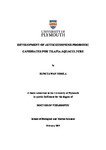DEVELOPMENT OF AUTOCHTHONOUS PROBIOTIC CANDIDATES FOR TILAPIA AQUACULTURE
| dc.contributor.supervisor | Merrifield, Daniel | |
| dc.contributor.author | Yomla, Rungtawan | |
| dc.contributor.other | School of Biological and Marine Sciences | en_US |
| dc.date.accessioned | 2019-04-05T08:16:56Z | |
| dc.date.issued | 2019 | |
| dc.date.issued | 2019 | |
| dc.identifier | 10423766 | en_US |
| dc.identifier.uri | http://hdl.handle.net/10026.1/13664 | |
| dc.description.abstract |
This programme of work sought to develop autochthonous probiotic solutions for tilapia aquaculture. Initial work began with the isolation of isolate 34 bacterial cultures from the tilapia intestine, which were tested for probiotic potential in vitro. Fifteen isolates displayed positive probiotic properties in in vitro assays. The selection of high potential probiotic candidates was based on multi-parameter properties using the Z−score method, which ranked isolates identified as Bacillus sp. CHP02 (Z score = 1.48), Bacillus sp. RP01 (1.14) and Bacillus sp. RP00 (1.09) as having the greatest potential. These isolates, along with Enterobacter sp. NP02 (0.50), were then assessed for their efficacy as probiotic candidates in vivo. Six experimental groups: T1: (Bacillus sp. CHP02 + a commercial feed), T2 (Bacillus sp. RP01 + a commercial feed), T3 (Bacillus sp. RP00 + a commercial feed), T4 (Enterobacter sp. NP02 + a commercial feed), T5 (P. acidilactici + a commercial feed) and T6 (only + a commercial feed) were designed for evaluation in both fry and on-growing stages of tilapia. Bacillus sp. RP01 application to feeds induced positive effects on tilapia larvae including improved body weight, total weight gain, average daily growth, specific growth rate and resistance to A. hydrophila challenge. However, these beneficial effects were not observed when applied in on-growing sized tilapia. The results suggest that the Z-score method could be used to select high potential of autochthonous probiotics for fry, but the applicability in the current research programme was less robust at later life stages. It is hypothesised that different probiotic strains may be required for application during different life stages, which may reflect the different physiologies of tilapia, and their likely differing microbiomes, at different life histories. Further research is required to select probiotics by using re-isolation and both in vitro and in vivo trials across the whole tilapia production cycle. | en_US |
| dc.description.sponsorship | King Mongkut's Institute of Technology Ladkrabang's Foundation, Thailand | en_US |
| dc.language.iso | en | |
| dc.publisher | University of Plymouth | |
| dc.rights | CC0 1.0 Universal | * |
| dc.rights.uri | http://creativecommons.org/publicdomain/zero/1.0/ | * |
| dc.subject | Selection | |
| dc.subject | Tilapia | |
| dc.subject | In Vivo | |
| dc.subject | In Vitro | |
| dc.subject | Growth | |
| dc.subject | Stress | |
| dc.subject | Microscopic study | |
| dc.subject | Autochthonous probiotics | en_US |
| dc.subject.classification | PhD | en_US |
| dc.title | DEVELOPMENT OF AUTOCHTHONOUS PROBIOTIC CANDIDATES FOR TILAPIA AQUACULTURE | en_US |
| dc.type | Thesis | |
| plymouth.version | publishable | en_US |
| dc.identifier.doi | http://dx.doi.org/10.24382/760 | |
| dc.rights.embargodate | 2020-04-05T08:16:56Z | |
| dc.rights.embargoperiod | 12 months | en_US |
| dc.type.qualification | Doctorate | en_US |
| rioxxterms.version | NA |
Files in this item
This item appears in the following Collection(s)
-
01 Research Theses Main Collection
Research Theses Main



